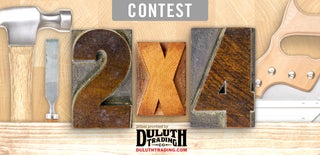Introduction: Plyometric Box
My workshop is full of leftover pieces of plywood and lumber. I have no trouble in discarding them if they're shorter than a piece of firewood, but any longer and I figure I ought to be able to use them at some stage down the line. Of course, mostly I don't, so they accumulate. Rather than indulge in a frenzy of chopping them up for burning, I decided to make something. I had recently watched Mathias Wandel make an interesting and attractive joint for box construction. However, said box looked better from the outside than the inside, so I thought I'd use the joinery to make a box that only needed an outside, namely a plyometric box for the gym. You can make them completely out of plywood, see "Related" column to the right (or just buy![]() one, of course), but I wanted one with no exposed plywood edges and no metal fasteners and Mathias' method would allow me to achieve that.
one, of course), but I wanted one with no exposed plywood edges and no metal fasteners and Mathias' method would allow me to achieve that.
Step 1: Design, Materials and Tools
Plyometric boxes can be pretty big, and my offcuts didn't stretch to making one 20 × 24 × 30" (a common size). I made mine 16 × 20 × 24" instead (actually 400 × 500 × 600 mm, and all measurements henceforth will be in mm). That meant I needed the following:
Two sheets of 15 mm (5/8") plywood 356 × 456 mm
Two sheets of 15 mm (5/8") plywood 356 × 556 mm
Two sheets of 15 mm (5/8") plywood 456 × 556 mm
6 meters of 2×2 (actually 38 × 38 mm). I ripped mine out of recycled 2×4 construction lumber.
Wood glue
Miller dowels![]() (or other fasteners, e.g. drywall screws)
(or other fasteners, e.g. drywall screws)
Usually I say in my projects that I used a table saw and miter saw but that you could do it using a handsaw or circular saw instead if that's all you have. Not in this case. This project required making about 100 cuts on the table saw plus 48 perfect miter cuts, and took me most of a day to build, even with the right tools. Don't even try it without them. I also used a belt sander, lots of spring clamps, and a cordless drill for adding the fasteners.
Step 2: Cut
Cut the 356 × 556 and 456 × 556 sheets to size. Set aside the plywood for the two 356 × 456 pieces - cut these once you have constructed the rest of the box.
To make the edges, you need to rip two 15 × 15 mm squares out of your pieces of 38 × 38 mm lumber, out of the diagonally opposite corners as shown. Do so by setting the height of your table saw blade to the thickness of the plywood, and the outside of the blade to the thickness of the plywood away from the fence.
Cut the resulting funny profile into 4 lengths of >600, 4 lengths of >500, and 4 lengths of >400 mm. You're going to miter them a little later.
Step 3: Assemble Square
Assemble the two 456 × 556 mm and two 356 × 556 mm sheets into an open ended box using 4 pieces of mitered 600 mm long profile. I NEVER measure for a miter joint, I always mark - it's the only way I can get perfect joints. Note that you will need a well-adjusted miter saw to get this right, because you will be swinging it between the 45 degree stops a lot. I cut one end of all 12 pieces first, then did all the rest individually after marking.
Glue and clamp and use whatever fasteners you feel like using. I used Miller dowels because I like them a lot and that way the box could be entirely wooden, but screws are fine too. I added 2 Miller dowels on each edge, for no other reason than I had 49 to hand and this layout would consume 48. I rubbed sawdust into the gaps where the wood glue squeezed out - this is a cheap and easy way to fill the cracks. I went over any other holes the same way (and there were a lot, all the wood I used being recycled).
Note that I didn't quite have enough sheets of plywood for all six sides, so I joined two smaller pieces for one of the sides. One of the benefits of not seeing the inside of the box is that I could just slap a big ugly scab on the inside to join the two pieces.
Also note that I removed the paint on the inside of the box where the plywood needed to be glued. You don't get a strong joint with paint in the way. I did this with my router table with a 15 mm wide bit set at slightly more than the paint thickness high.
Step 4: Reinforcement
I added an intersecting cross of plywood to support the two longest sides, to prevent any flexing when someone heavy (like me) jumps on the box.
Step 5: Add Top and Bottom
The top and bottom of the box will be made from the remaining two sheets of plywood, plus the eight pieces of profile. Mark and measure and cut and glue and fasten each piece of profile in place, to leave you a hole which should be pretty close to 356 × 456 mm. But measure it exactly, and cut the plywood to fit perfectly. Drop it in the pre-glued hole, put weight on the top and fasten it in place.
Step 6: Finish
I belt sanded with 80-grit sandpaper. I really liked the look of it with sharp edges, but the whole point of making the box with no plywood edges and no metal fasteners was so that I could round over the edges and it would still look good, so I did that, then sanded again with an orbital sander and 120-grit, then polyurethaned the whole thing twice.
Step 7: Exercises
So what do you do with a plyometric box? Well, it is basically a platform that provides solid support at three different heights. Plyometrics![]() aim to train speed and explosiveness, so jumping on and off the box is the main purpose of having one. However, there are a ton of other exercises where it's useful to have one around - you can jump onto it, or step up on it, you can use it to elevate your feet to make pushups harder, you can do dips or asymmetric pushups. You could also use it as a chair to play video games.
aim to train speed and explosiveness, so jumping on and off the box is the main purpose of having one. However, there are a ton of other exercises where it's useful to have one around - you can jump onto it, or step up on it, you can use it to elevate your feet to make pushups harder, you can do dips or asymmetric pushups. You could also use it as a chair to play video games.
Warning: be aware of your ceiling height. Me + box in highest position = 8' 4". Gym ceiling height = 8'...

Participated in the
2x4 Contest

Participated in the
Leftovers Challenge













